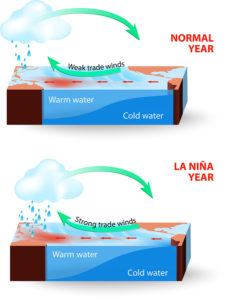With the end of a Pacific La Nina and no clear signal of where ocean temperatures are heading, predicting spring and summer weather that will impact agriculture and energy markets just got a little harder.
A weak La Nina, which starts when the equatorial Pacific cools, has ended, the U.S. Climate Prediction Center said in a report Thursday. With its collapse, the U.S. raised the odds that a El Nino could form by the end of 2017 to 50 percent from 36 percent, though the agency has yet to issue a watch for the ocean-warming phenomenon.

That has left the Pacific in so-called “neutral” or normal conditions, with no dominating weather pattern, and traders without an important tool to predict how temperatures and rainfall may impact markets. Last year, a strong El Nino in the Pacific helped meteorologists forecast the winter of 2015-2016.
“There is nothing pushing the atmosphere in a certain direction,” Michelle L’Heureux, a forecaster with the Climate Prediction Center in College Park, Maryland, said in a telephone interview. “Neutral for us means the predictability is more limited.”
The cooling and the warming of the Pacific, which can upset global weather patterns, has the biggest impact on the U.S. in the fall, winter and spring. La Nina and El Nino can affect crop yields, demand for natural gas used to heat homes and electricity rates. Many long-term forecasts hinge on what the Pacific may do.
Cooler Winters
It’s still too early to issue a El Nino watch since the best chances for the event to form are more than six months away, L’Heureux said. El Nino’s can cut down on wind shear across the Atlantic making it easier for hurricanes to form, and have been known to bring cooler and stormier winters across the South.
“We’re not quite at the point where we feel confident enough to say that things are developing toward El Nino,” she said.
In November, the U.S. declared a weak La Nina started in the Pacific, which signaled the chances of a colder winter across upper Great Plains. The event was so feeble it failed to meet the criteria used by the Australian Bureau of Meteorology, which never acknowledged it.
While ocean temperatures have become too warm for La Nina, the atmosphere is acting as if the phenomenon is still in play, L’Heureux said.
“Even now over the U.S., you cannot rule out there is some lagging influence,” she said.
Was this article valuable?
Here are more articles you may enjoy.

 California Bill Would Require Insurer Claims Handling Plans, And Double Penalties
California Bill Would Require Insurer Claims Handling Plans, And Double Penalties  Musk’s xAI Faces California AG Probe Over Grok Sexual Images
Musk’s xAI Faces California AG Probe Over Grok Sexual Images  Storm Goretti Batters Europe With Violent Winds, Power Cuts
Storm Goretti Batters Europe With Violent Winds, Power Cuts  NYC Sues Delivery App Over Lost Pay in New Mamdani Crackdown
NYC Sues Delivery App Over Lost Pay in New Mamdani Crackdown 